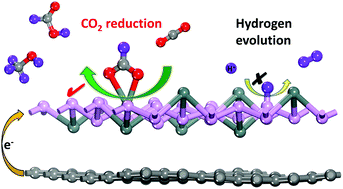Tuning the electronic structures of monolayer triphosphides MP3 (M = Sn and Ge) for CO2 electroreduction through interface engineering: a theoretical prediction
Abstract
Interface engineering by integrating various two-dimensional materials to form heterostructures can not only preserve the desired properties of individual components, but also induce new functions. Herein, by means of density functional theory (DFT) computations, we have investigated the effects of interface engineering of the graphene substrate on the electronic structures of monolayer triphosphides MP3 (M = Sn and Ge) and their catalytic performance for the electroreduction of carbon dioxide (CO2ER). Our results revealed that the MP3/graphene interfaces exhibit good structural stability, enhanced electrical conductivity, superior CO2ER performance, and obvious suppressing effects on hydrogen evolution due to the charge transfer at the interface. Thus, our results suggested that SnP3/graphene and GeP3/graphene heterostructures can be utilized as promising CO2ER catalysts with high-efficiency and high-selectivity, offering cost-effective opportunities to convert CO2 for renewable energy supply via interface engineering.



 Please wait while we load your content...
Please wait while we load your content...